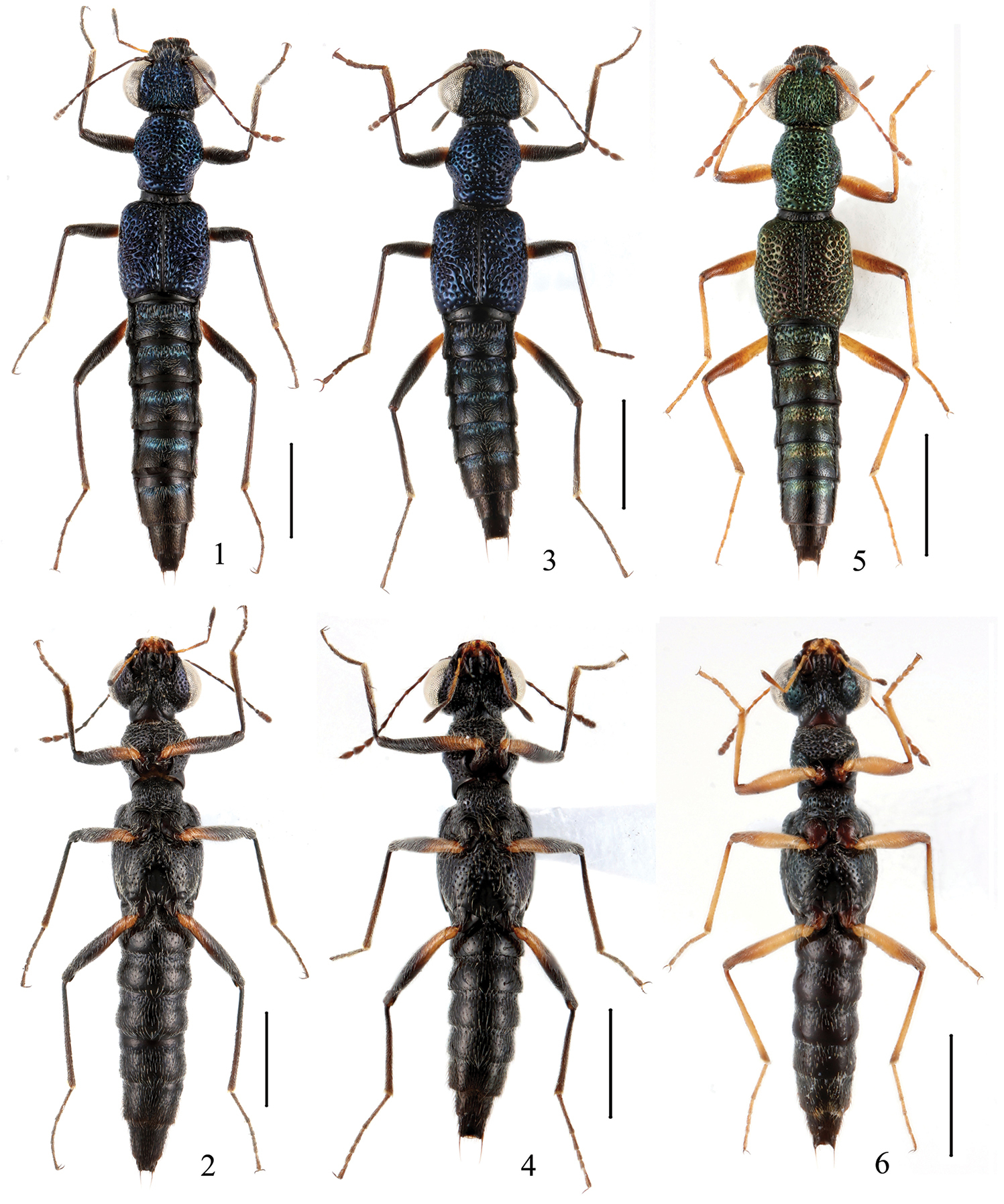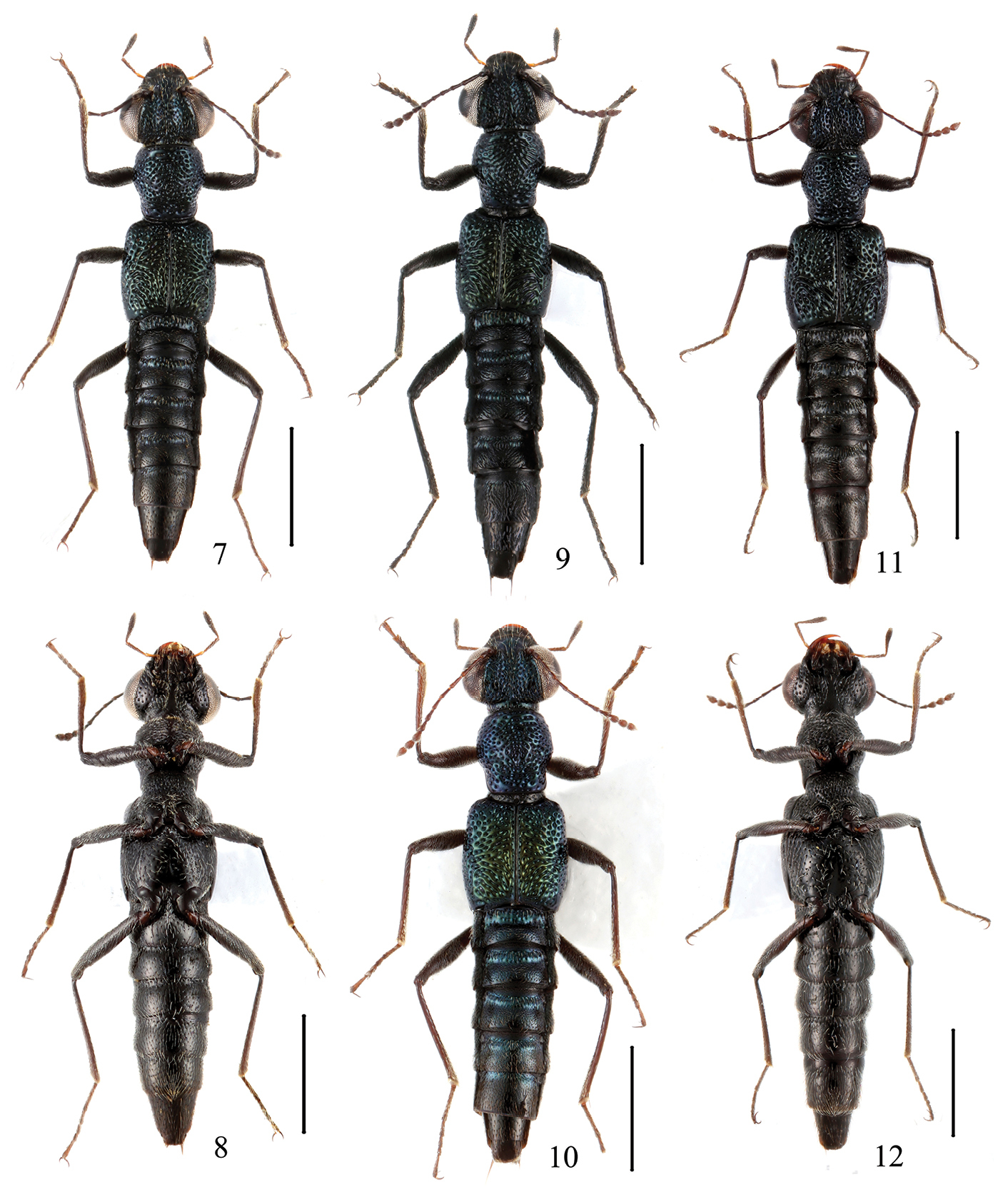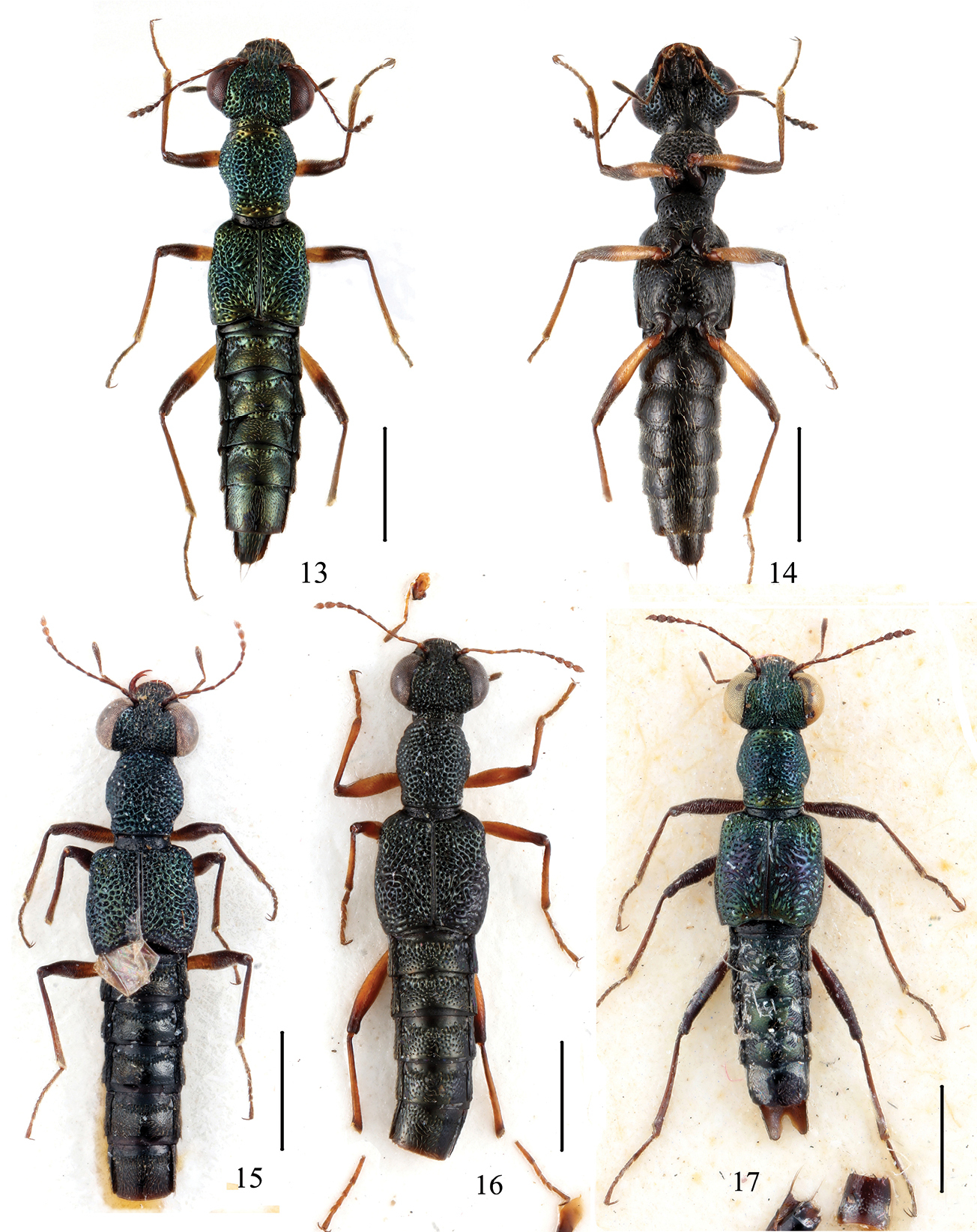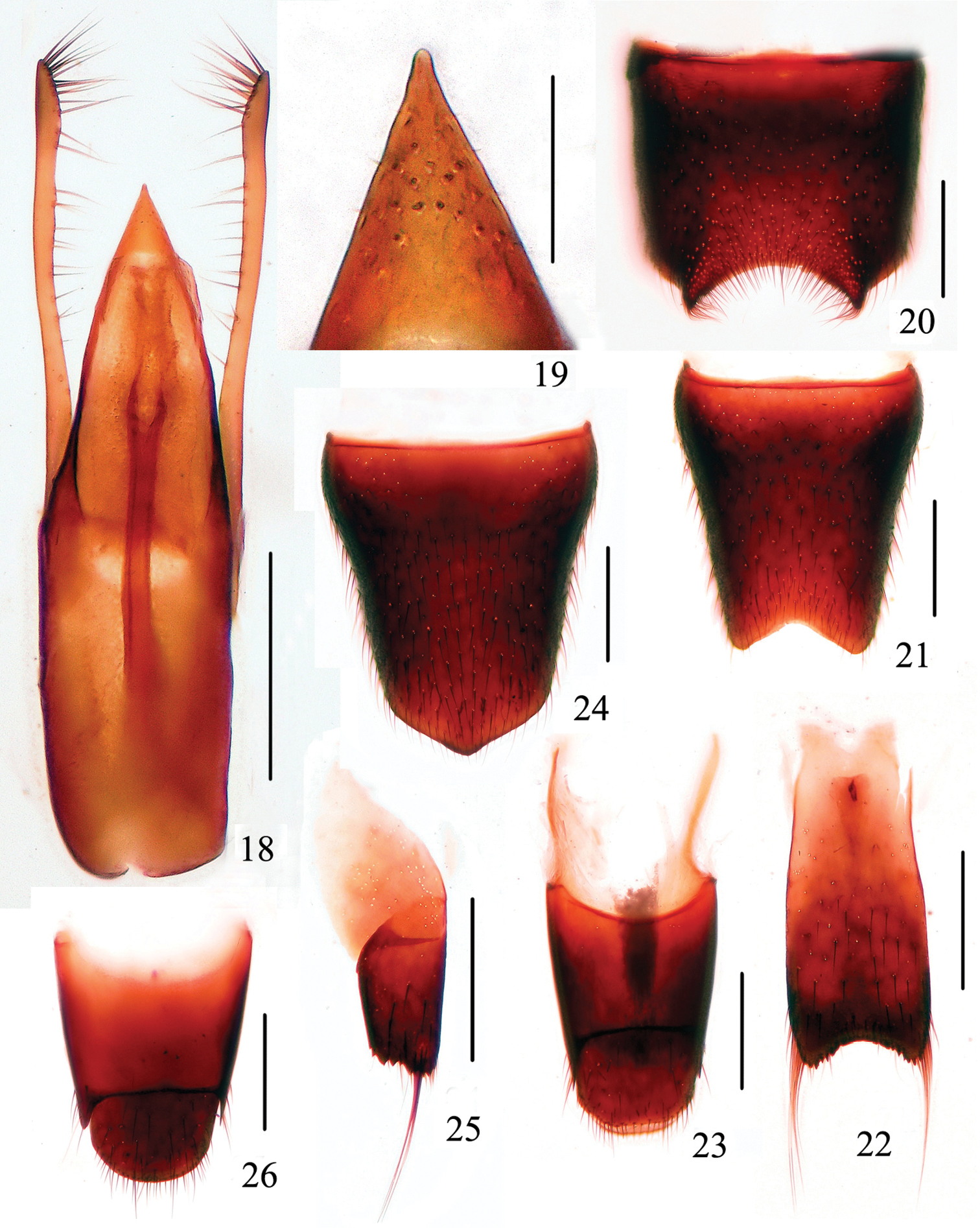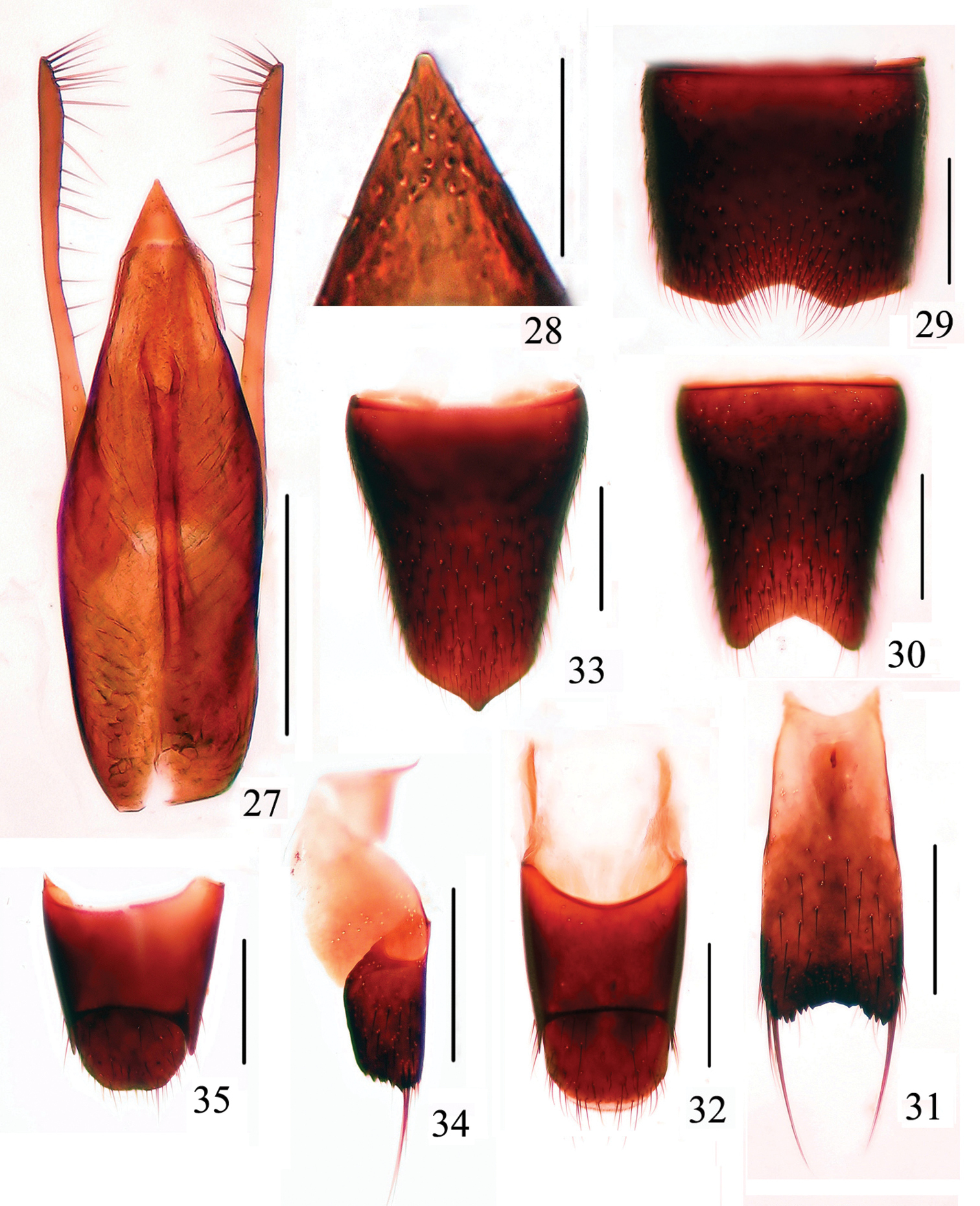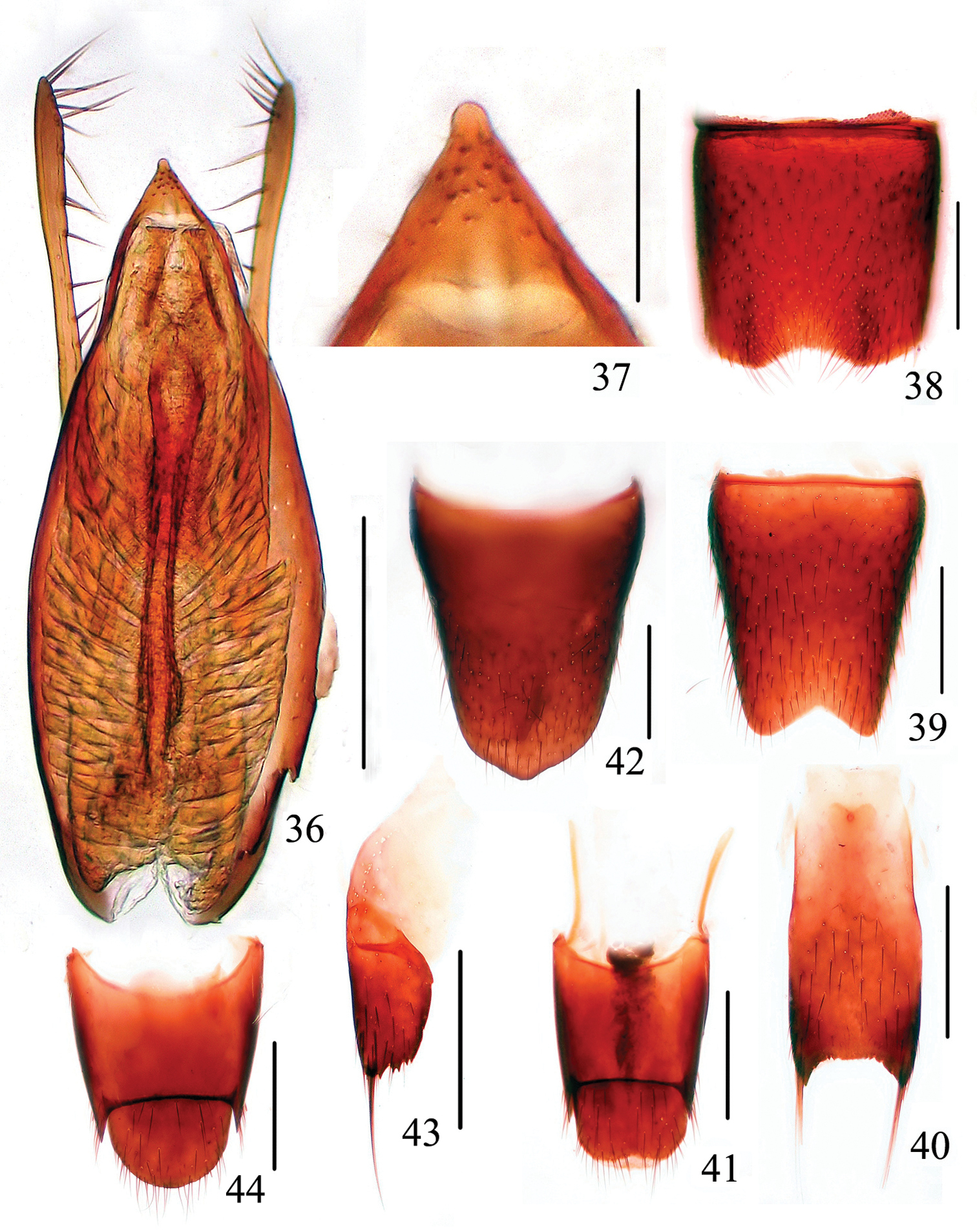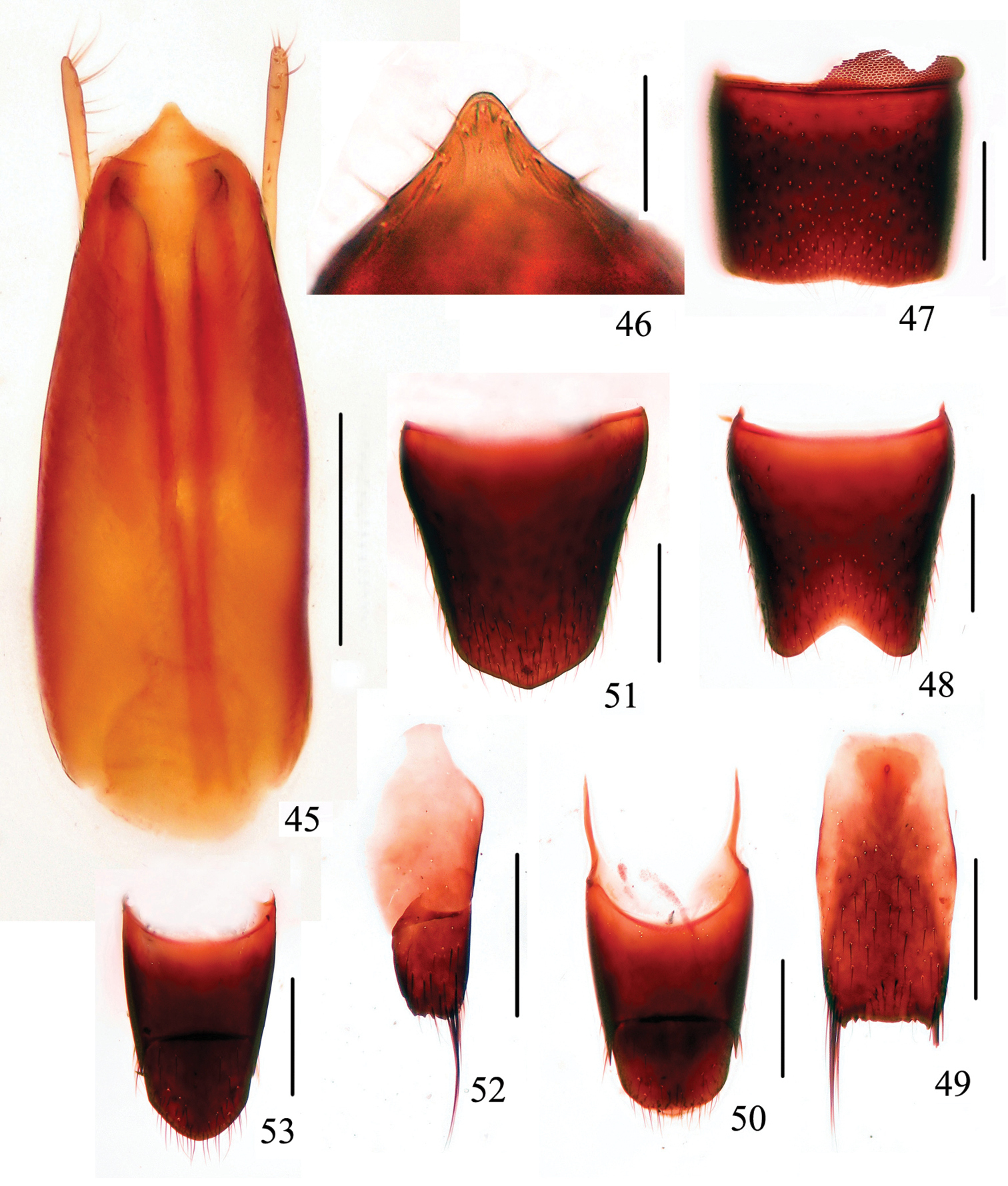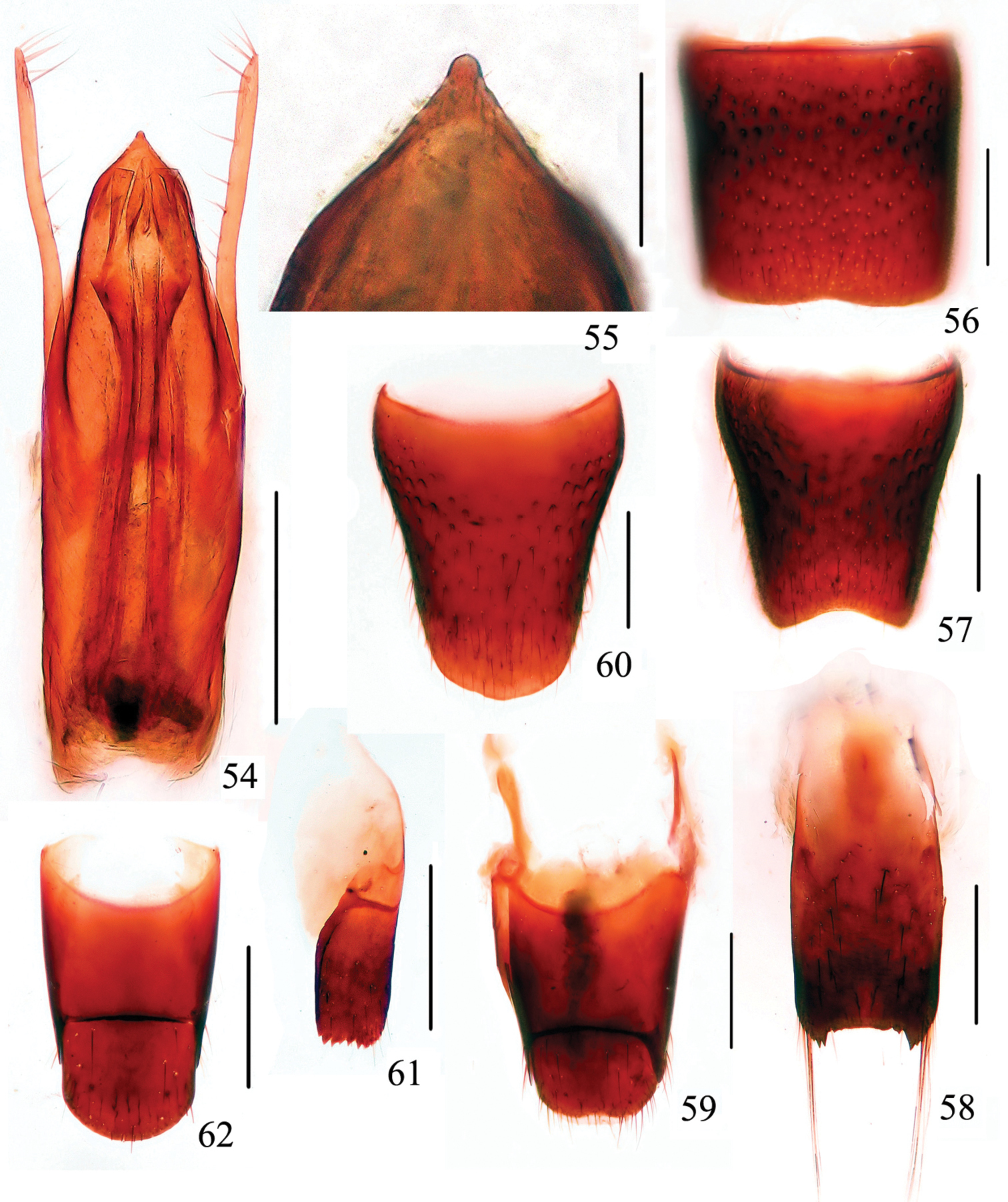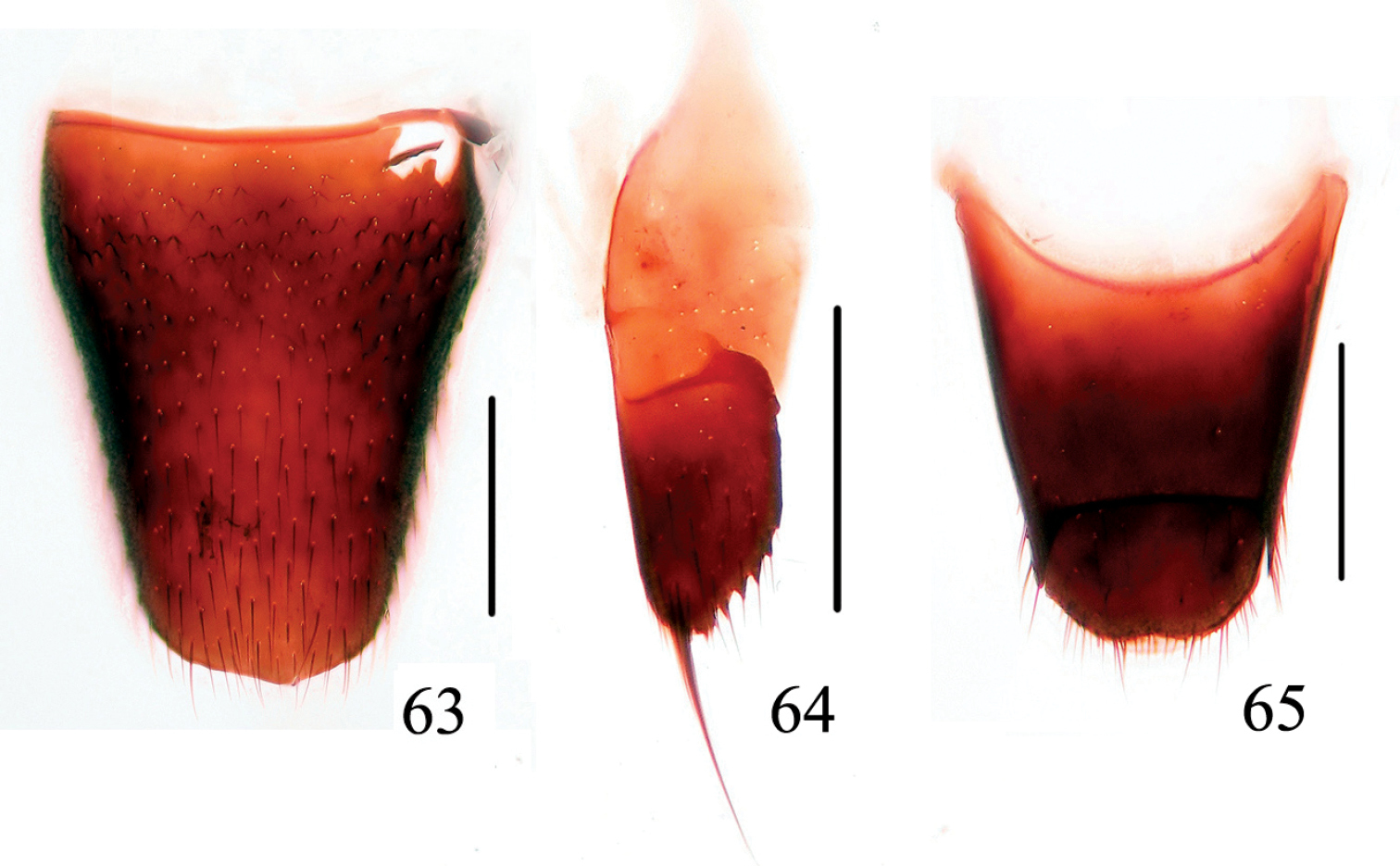(C) 2011 Liang Tang. This is an open access article distributed under the terms of the Creative Commons Attribution License, which permits unrestricted use, distribution, and reproduction in any medium, provided the original author and source are credited.
For reference, use of the paginated PDF or printed version of this article is recommended.
Chinese species of Dianous group I are studied and three new species are described: Dianous fengtingae sp. n. from Hainan Province, Dianous zhujianqingi sp. n. from Jiangxi and Guizhou Province, and Dianous huanghaoi sp. n. from Yunnan Province. Dianous shan Rougemont and Dianous viridicupreus Rougemont are discovered from China for the first time. Their diagnostic characters are illustrated and a key to Chinese species of Dianous group I is provided.
Coleoptera, Staphylinidae, Dianous, Group I, China
The members of Dianous group I have large eyes and simple tarsi, and therefore were regarded as Stenus by earlier entomologists. In 1981 Puthz made a systematic comparison between these two genera and revealed that this group without protrudable labium surely belonged to Dianous. To distinguished it from other members of Dianous, the following characters can be used: eyes large, usually without temples; tarsi simple, without tarsal shoes; frons with median portion not elevated.
Up to the present, 59 species of Dianous
group I have been described, which account for nearly 30 percent of
the genus. All of the species are distributed in the Oriental region and
seem to be rare. In Chinese fauna, only four species were previously
reported by
Specimens examined in this paper were all collected near streams through forests and killed with ethyl acetate. For examination of male genitalia, the last three abdominal segments were detached from the body after softening in hot water. The aedeagus together with other dissected pieces were mounted in Euparal (Chroma Geselschaft Schmidt, Koengen, Germany) on plastic slides. Photos of sexual characters were taken with Cannon G7 attached to Olympus SZX 16 stereoscope; habitus photos were taken with a Cannon macro photo lens MP-E 65mm attached to Cannon EOS40D camera.
The type specimens treated in this study are deposited in the following public and private collections:
SHNU Department of Biology, Shanghai Normal University, P. R. China
cPut private collection of V. Puthz, Schlitz, Germany
cRou private collection of G.-M. de Rougemont, London, England
The measurements of proportions are abbreviated as follows:
BL body length, measured from the anterior margin of the clypeus to the posterior margin of 10th abdominal tergite
FL forebody length, measured from the anterior margin of the clypeus to the apex of the elytra (apicolateral angle)
HW width of head including eyes
PW width of pronotum
EW width of elytra
PL length of pronotum
EL length of elytra, measured from humeral angle
Results Key to Chinese species of Dianous group I| 1 | Pronotum bicolorous with golden bands along the anterior and posterior margins | 2 |
| – | Pronotum unicolorous | 3 |
| 2 | Head distinctly broader than elytra; femora bicolorous. Habitus (Figs 13, 14), aedeagus (Fig. 3 in Rougemont 1985), female sexual characters (Figs 63–65). BL: 4.8–5.0 mm | Dianous viridicupreus Rougemont |
| China (Xizang), Nepal | ||
| – | Head narrower than elytra; femora unicolorous. Habitus (Figs 17), sexual characters (Figs 6–10 in Shi & Zhou 2010). BL: 4.3–5.3 mm | Dianous viriditinctus (Champion) |
| China (Xizang), India, Nepal, Bhutan | ||
| 3 | Body, at least head and pronotum, metallic green or golden green | 4 |
| – | Body, at least head and pronotum, metallic blue or black with plumbeous lustre | 6 |
| 4 | Elytra relatively narrow, head about as broad as elytra; punctures on head and pronotum moderate in size and distinctly separated, interstices can be as broad as half the diameter of a puncture. Habitus (Figs 5, 6), sexual characters (Figs 36–44). BL: 4.5 mm | Dianous shan Rougemont |
| China (Yunnan), Myanmar, Thailand | ||
| – | Elytra relatively broad, head distinctly narrower than elytra; punctures on head and pronotum very coarse and very dense, interstices narrow and sharp | 5 |
| 5 | Frons between eyes sharply inclined inward forming a deep and broad concavity; punctures on elytra mostly distinctly delimited; paratergites of abdominal tergite 4 broad, slightly declivous. Habitus (Figs 15), aedeagus (Figs 2 in Rougemont, 1981a ). BL: 4.0–5.2 mm | Dianous yao Rougemont |
| China (Guizhou), Myanmar, Thailand | ||
| – | Frons between eyes gently inclined inward forming a shallow and broad concavity, traces of two lateral longitudinal furrows can be recognized at posterior portion of the concavity; punctures on elytra mostly transversely or diagonally confluent; paratergites of abdominal tergite 4 narrow, slightly reflexed. Habitus (Figs 16), male unknown. BL: 4.5–5.2mm | Dianous limitaneus Puthz |
| China (Yunnan) | ||
| 6 | Forebody distinctly metallic blue; femora bicolorous | 7 |
| – | Forebody black with plumbeous lustre, sometimes elytra with brassy reflection; femora unicolor | 8 |
| 7 | punctures on frons deep and dense; posterior half of elytra with vorticose sculpture. Habitus (Figs 11, 12), sexual characters (Figs 54–62). BL: 4.6–5.0 mm | Dianous huanghaoi sp. n. |
| China (Yunnan) | ||
| – | punctures on frons shallow and sparse; posterior half of elytra with transverse sculpture. Habitus (Figs 7–10), sexual characters (Figs 45–53). BL: 3.7–4.4 mm | Dianous zhujianqingi sp. n. |
| China (Jiangxi, Guizhou) | ||
| 8 | Punctation of pronotum and elytra coarser and less confluent; posteromedian part of 7th male sternite (Fig. 29) flattened, without keels. Habitus (Figs 3, 4), sexual characters (Figs 27–35). BL: 4.5–4.9 mm | Dianous fengtingae sp. n. |
| China (Hainan) | ||
| – | Punctation of pronotum and elytra smaller and confluent; posteromedian part of 7th male sternite (Fig. 20) with an impression limited by raised keels laterally, and two acute backward projections at its posterior margin. Habitus (Figs 1, 2), sexual characters (Figs 18–26). BL: 4.4–5.9 mm | Dianous tonkinensis (Puthz) |
| China (Yunnan, Hunan), Vietnam, Thailand, Borneo, Indonesia | ||
http://species-id.net/wiki/Dianous_tonkinensis
Figs 1, 2, 18–26CHINA: Yunnan: male, Nabanhe N. R., Mandian, 12.I.2004, Li Li-Zhen & Tang Liang leg. (SHNU); male and female, Nabanhe N. R., Nabancun, N22°10.032, E100°39.359, alt. 720m, 6.V.2009, Hu Jia-Yao & Yin Zi-Wei leg. (SHNU); Hunan: male, Wufeng Town, Houhe N. R., 20. IX.2003, Ohbayashi Nobuo leg. (SHNU)
Adult habitus of Dianous. 1, 2 Dianous tonkinensis 3, 4 Dianous fengtingae 5, 6 Dianous shan. Scales = 1 mm.
China (Yunnan, Hunan), Vietnam, Thailand, Borneo, Indonesia.
urn:lsid:zoobank.org:act:54B5B60C-2D53-41A9-9B0B-0439F3466B20
http://species-id.net/wiki/Dianous_fengtingae
Figs 3, 4, 27–35Holotype. China: Hainan: male, glued on a card with labels as follows: “China: Hainan Prov., Ledong County, Jianfengling N. R., alt. 900m, 16.IV.2010, Feng & Yuan leg.” “Holotype / Dianous fengtingae / Tang & Li” [red handwritten label] (SHNU). Paratypes. male and 4 females, same data as for the holotype. (SHNU); female, Changjiang County, Bawangling, alt. 1000m, 14.XI.2006, Li Li-Zhen leg. (SHNU); 4 females, Changjiang County, Bawangling, alt. 450–650m, 13.IV.2010, Zhu Jian-Qing leg. (female in cPut, female in cRou, rest in SHNU).
Body entirely black, head, pronotum, elytra and basal abdominal tergites with a blue metallic lustre. Antennae blackish brown, with club segments lighter. First two segments of maxillary palpi brownish yellow, last segment brown. Legs blackish with tibiae and tarsi slightly lighter, femora yellowish in basal third.
BL: 4.5–4.9mm; FL: 2.5–2.6 mm.
Proportions of holotype: HW: 63.5, PW: 47, PL: 53, EW: 61, EL: 67.
Head 1.04 times as wide as elytra; interocular area gently inclined inward forming a shallow and broad concavity; punctures round, distinctly delimited, slightly larger on median area than near dorsal margins of eyes, diameter of large punctures about as wide as widest cross section of 2nd antennal segment, interstices smooth, mostly smaller than half diameter of punctures. Antennae when reflexed exceeding posterior margin of pronotum; length of segments from base to apex: 10.0: 7.0: 17.5: 11.0: 9.0: 8.0: 8.0: 7.0: 7.0: 8.0: 10.0.
Pronotum 1.28 times as long as wide, widest slightly before middle and constricted at base; punctures round, partially slightly confluent, distinctly larger than those on frons, interstices smooth, mostly smaller than half diameter of punctures.
Elytra nearly rectangular; punctation on average slightly coarser than that of pronotum, punctures on humeral area mostly distinctly delimited, and those on inner 2/3 portion of elytra (especially those on posterior half) obliquely confluent, interstices similar to those on pronotum.
Length of metatarsi from base to apex: 11.5: 8.5: 5.5: 3.5: 10.5.
Abdomen subcylindrical; 3rd to 6th segments with broad and densely punctate paratergites, paratergites of tergite 4 narrower than greatest width of hind tibia; 7th tergite with an apical membranous fringe; punctures on 3rd tergite as large as one eye facet, interstices smooth.
Male. Seventh sternite (Fig. 29) with a distinct posteriomedian emargination, 8th sternite (Fig. 30) with a broad triangular emargination posteromedially; 9th sternite (Fig. 31) with the apicolateral portion serrate, posterior margin slightly emarginate; 10th tergite (Fig. 32) with the posterior margin broadly rounded. Median lobe of aedeagus (Fig. 18) with an acutely pointed and setose apex (Fig. 19), parameres extending far beyond the apex of median lobe.
Female. Sternite 8 (Fig. 33) pointed posteromedially; valvifer (Fig. 34) with the posterior margin serrate; 10th tergite (Fig. 35) with the posterior margin truncate.
China (Hainan).
The new species is similar to Dianous tonkinensis (Puthz, 1968) from South Asia and Dianous lividus (L.
http://species-id.net/wiki/Dianous_shan
Figs 5, 6, 36–44CHINA: Yunnan: male, Nabanhe N. R., Bengganglahu, 15.I.2004, Li Li-Zhen & Tang Liang leg. (SHNU); female, Nabanhe N. R., Nabancun, N22°09.305, E100°41.291, alt. 620m, 18.XI.2008, Tang Liang leg. (SHNU)
China (Yunnan), Myanmar, Thailand.
urn:lsid:zoobank.org:act:03F6F311-0FA5-4860-A53B-1F53A74F970A
http://species-id.net/wiki/Dianous_zhujianqingi
Figs 7–10, 45–53Holotype. China: Jiangxi: male, glued on a card with labels as follows:“China: Jiangxi Prov., Yushan County, Mt. Sanqingshan, alt. 1000–1200m, 16.X.2010, Peng, Zhai & Zhu leg.” “Holotype / Dianous zhujianqingi / Tang & Li” [red handwritten label] (SHNU). Paratypes. 14 males and 19 females, same data as for the holotype (1 pair in cPut, 1 pair in cRou, rest in SHNU); male and female, Sanqingshan, alt. 700–1000m, 4.V.2005, Hu Jia-Yao & Tang Liang leg. (SHNU); Guizhou: male and 2 females, Mt. Fanjing, 23.VII.2003, Li Li-Zhen, Hu Jia-Yao & Tang Liang leg. (SHNU)
Body entirely black with a faint plumbeous lustre, elytra sometimes with brassy reflection. Antennae blackish brown. Maxillary palpi with first segment yellowish, second segment light brown and last segment brown. Legs black with a brownish tint, tibiae and tarsi slightly lighter.
BL: 3.7–4.4 mm; FL: 2.1–2.3mm.
Proportions of holotype: HW: 58.0, PW: 44.5, PL: 49.0, EW: 59.0, EL: 63.5.
Head about as wide as elytra; lateral portions of front slightly rising, medial portion concave; punctures round, distinctly delimited, slightly larger on median area than near dorsal margins of eyes, diameter of large punctures about as wide as apical cross section of 3rd antennal segment, interstices smooth, smaller than or as broad as half diameter of punctures. Antennae when reflexed extending to the posterior margin of pronotum; Length of segments from base to apex: 9.0: 6.5: 9.0: 8.0: 8.0: 5.5: 8.0: 6.0: 7.0: 6.5: 9.0.
Pronotum 1.10 times as long as wide, widest slightly before middle and constricted at base; punctures partially confluent, diameter of large punctures about as wide as apical cross section of 2nd antennal segment, interstices smooth, mostly smaller than or about as broad as half diameter of punctures.
Elytra nearly rectangular; punctation similar to that of the pronotum, punctures on humeral area mostly distinctly delimited, those on medial two thirds obliquely confluent, interstices similar to those on pronotum.
Length of metatarsi from base to apex as 18.5: 8.0: 5.5: 4.0: 11.5.
Abdomen subcylindrical; 3rd to 6th segments with broad and densely punctate paratergites, paratergites of 4th tergite as broad as greatest width of hind tibia; 7th tergite with an apical membranous fringe; punctures on 3rd tergite slightly smaller than one eye facet, interstices with very indistinct microsculpture.
Male. Seventh sternite (Fig. 47) with a very shallow emargination posteromedially, 8th sternite (Fig. 48) with a triangular emargination posteromedially; 9th sternite (Fig. 49) with distinct apicolateral projections, posterior margin slightly serrate and almost straight; 10th tergite (Fig. 50) with posterior margin broadly round. Median lobe of aedeagus (Fig. 45) with a triangularly pointed and setose apex (Fig. 46), a pair of distinct expulsion hooks, parameres extending far beyond the apex of median lobe.
Female. Eighth sternite (Fig. 51) pointed posteromedially; valvifer (Fig. 52) with posterior margin finely serrate; 10th tergite (Fig. 53) with the posterior margin broadly pointed.
China (Jiangxi, Guizhou)
In a few specimens the punctation of pronotum and elytra is strongly confluent as in Fig. 9. Two specimens show more a distinct brassy reflection on elytra and blue metallic reflection on basal tergites (Fig. 10).
The new species slightly resembles Dianous cyaneovirens (Cameron, 1930) from India, Nepal, Bhutan and Dianous bracteatus (Champion, 1920) from India, and Nepal. From both it may be easily distinguished by the faint metallic coloration (Dianous cyaneovirens and Dianous bracteatus: strongly metallic green), and from Dianous bracteatus also by darker legs.
Adult habitus of Dianous.7–10 Dianous zhujianqingi 11, 12 Dianous huanghaoi. Scales = 1 mm.
urn:lsid:zoobank.org:act:26B88EFE-CE9D-4AE4-9B4A-959AC5225830
http://species-id.net/wiki/Dianous_huanghaoi
Figs 11, 12, 54–62Holotype. China: Yunnan: male, glued on a card with labels as follows:“Zhonghutiao, Hutiaoxia Coun., Yunnan Prov., 24.IV.2005, Huang Hao leg.” “Holotype / Dianous Huanghaoi / Tang & Li” [red handwritten label] (SHNU). Paratypes. 2 males and 5 females, same data as for the holotype. (1 pair in cPut; rest in SHNU); 2 females, Yushuizhai, Lijiang, alt. 2600m, 14.IV.2003, stream moss, G. de Rougemont leg. (cRou)
Body entirely black with a faint plumbeous lustre. Antennae blackish brown, antennal club slightly lighter than preceding segments. Maxillary palpi brownish. Legs black with a brownish tint, tibiae and tarsi slightly lighter.
BL: 4.6–5.0mm; FL: 2.6–2.7mm.
Proportions of holotype: HW: 59.5, PW: 44.0, PL: 50.5, EW: 66.0, EL: 69.5.
Head 0.9 times as wide as elytra; lateral portions of frons slightly raised, median portion concave; punctures round to elliptic, distinctly delimited, slightly larger on median area than near dorsal margins of eyes, diameter of largest punctures about as wide as basal cross section of 2nd antennal segment, interstices smooth, smaller than or as broad as half diameter of punctures. Antennae when reflexed extending to the posterior margin of pronotum; Length of segments from base to apex as 9.5: 6.5: 14.5: 8.5: 7.5: 6.5: 7.0: 5.5: 6.0: 5.5: 8.0.
Pronotum 1.15 times as long as wide, widest slightly before middle and constricted at base; punctures partially confluent, similar in size to those on head, interstices similar to those on frons.
Elytra nearly rectangular; punctation similar to that of the pronotum, punctures on humeral area mostly distinctly delimited, those on posterior half of elytra strongly confluent, forming a narrowly vorticose sculpture.
Relative length of segments of hind legs from base to apex as 15.0: 8.5: 5.5: 3.5: 14.5.
Abdomen subcylindrical; 3rd to 6th segments with broad and densely punctate paratergites, paratergites on 4th segment as broad as largest width of hind tibia; 7th tergite with an apical membranous fringe; punctures on 3rd tergite distinctly smaller than eye facet, interstices smooth.
Male. Seventh sternite (Fig. 56) with a very shallow emargination posteromedially, 8th sternite (Fig. 57) with a broad emargination posteromedially; 9th sternite (Fig. 58) with distinct apicolateral projections, posterior margin finely serrate and almost straight; 10th tergite (Fig. 59) with a shallow emargination at middle of posterior margin. Median lobe of aedeagus (Fig. 54) with a triangularly pointed and setose apex (Fig. 55), parameres extending far beyond the apex of median lobe.
Female. Eighth sternite (Fig. 60) with posterior margin hardly pointed at middle; valvifer (Fig. 61) with posterior margin serrate; 10th tergite (Fig. 62) with the posterior margin rounded.
China (Yunnan).
The new species is similar to Dianous carinipennis (
http://species-id.net/wiki/Dianous_viridicupreus
Figs 13, 14, 63–65CHINA: Xizang: 2 females, Nielamu County, Zhangmu Town, Lixin village, 27–28.VII.2010, alt. 2400–2600m, Zhu Jian-Qing leg.
China (Xizang), Nepal.
http://species-id.net/wiki/Dianous_yao
Fig. 15China (Guizhou), Myanmar, Thailand.
No Chinese material was examined by us; a photograph of a paratype (cPut) from Myanmar is provided here.
http://species-id.net/wiki/Dianous_limitaneus
Fig. 16Holotype: CHINA: Yunnan: female, Baoshan Xian, Gongshan Mts., Lujiaba, 2400m, 10.X.1996, K. Ishii et al. leg.
China (Yunnan).
This species was only known from the female holotype, which is actually deposited in “the collection of the Laboratory of Entomology, Tokyo University of Agriculture”, not in “Shanghai Institute of Entomology, Academia Sinica” (Present name: Shanghai Entomology Museum, the Chinese Academy of Science) as original published paper described.
http://species-id.net/wiki/Dianous_viriditinctus
Fig. 17China (Xizang), India, Nepal, Bhutan.
No Chinese material was examined by us, and a photograph of specimen (cPut) from Nepal is provided here.
We would like to express our sincere gratitude to dear Dr. V. Puthz (Germany) for his kind guidance on our study, to Mr. G.-M. de Rougemont (England) for the kind loan of specimens and other help, to Mr. Xian-Wei Liu (Shanghai), Dr. Y. Watanabe (Japan) and Dr. S. Nomura (Japan) for helping us to search for the holotype of D. limitaneus, to Mr. Yun Yang (Yunnan) and Mr. Mao-Xing Tian (Yunnan), Mr. Chang-Chin Chen (Taiwan), Mr. Wen-Xuan Bi (Shanghai), Mr. Xiao-Dong Yang (Sichuan) and Mr. Xiao-Yu Zhu (Jiangsu) for their warm support during the field work, and to all collectors mentioned in this paper. The research was supported by National Natural Science Foundation of China (No. 30870323), National Natural Science Foundation of Shanghai (No. 10ZR1421600), Shanghai Municipal Education Commission (No. RE904), Shanghai Normal University (No. SK200911), and Doctoral Fund of Shanghai Normal University (No. PL926).
Dianous tonkinensis. 18 aedeagus 19 apical portion of aedeagus 20 7th male sternite 21 8th male sternite 22 9th male sternite 23 9th and 10th male tergites 24 8th female sternite 25 valvifer 26 9th and 10th female tergites. Scales = 0.25 mm (18, 20–26), scales = 0.05 mm (19).
Dianous fengtingae. 27 aedeagus 28 apical portion of aedeagus 29 7th male sternite 30 8th male sternite 31 9th male sternite 32 9th and 10th male tergites 33 8th female sternite 34 valvifer 35 9th and 10th female tergites. Scales = 0.25 mm (27, 29–35), scales = 0.05 mm (28).
Dianous shan. 36 aedeagus 37 apical portion of aedeagus 38 7th male sternite 39 8th male sternite 40 9th male sternite 41 9th and 10th male tergites 42 8th female sternite 43 valvifer 44 9th and 10th female tergites. Scales = 0.25 mm (36, 38–44), scales = 0.05 mm (37).
Dianous zhujianqingi. 45 aedeagus 46 apical portion of aedeagus 47 7th male sternite 48 8th male sternite 49 9th male sternite 50 9th and 10th male tergites 51 8th female sternite 52 valvifer 53 9th and 10th female tergites. Scales = 0.25 mm (45, 47–53), scales = 0.05 mm (46).
Dianous huanghaoi. 54 aedeagus 55 apical portion of aedeagus 56 7th male sternite 57 8th male sternite 58 9th male sternite 59 9th and 10th male tergites 60 8th female sternite 61 valvifer 62 9th and 10th female tergites. Scales = 0.25 mm (54, 56–62), scales = 0.05 mm (55).
Dianous viridicupreus. 63 8th female sternite 64 valvifer 65 9th and 10th female tergites. Scales = 0.25 mm.







